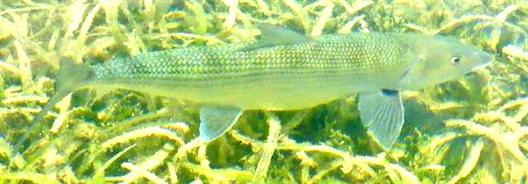



Albula vulpes
| Ecological Descriptors | ||||
| Habitat | Size | Diet | Behaviour | Sex |
| S/ De | to 70 | Cru, Wor, Mol | Sh | F |
Description:
Body elongated, silvery, with darkish areas at the tip of the snout and at the base of the pectoral fin. May display longitudinal bars. Dorsal fin single, tail deeply forked. Mouth short, subterminal, ending before the eye.
Ecology
Inhabits shallow coastal waters, estuaries and bays over sand and mud bottoms, down to 84 m. Often in schools, except for large individuals that are solitary. Feeds on benthic worms, crustaceans and molluscs. Tolerates oxygen poor water by inhaling air into a lung-like airbladder. Since bonefish rely upon habitats of limited extent, they are especially susceptible to habitat loss.
Life Cycle:
Exhibits seasonal reproductive activity throughout its (from October through April) with most activity occurring in Autumn-Winter and early Spring months. Spawning is presumed to occur in deep water off the coral reef shelf edge, away from principal foraging grounds. They spawn primarily during the full moon phase but possibly at the new moon phase as well. They gather in pre-spawning aggregations in protected areas near deeper water. Spawning occurs at night. Recent aging of large bonefish has revealed that they live to at least 20 years. Growth is rapid until six years, when the growth rate slows. There are sexually dimorphic patterns of growth. Age at maturity is 3.5 years minimum, usually longer in Antigua, with the smallest sexually mature bonefish observed was 358 mm (Cayman Islands).
Body elongated, silvery, with darkish areas at the tip of the snout and at the base of the pectoral fin. May display longitudinal bars. Dorsal fin single, tail deeply forked. Mouth short, subterminal, ending before the eye.
Ecology
Inhabits shallow coastal waters, estuaries and bays over sand and mud bottoms, down to 84 m. Often in schools, except for large individuals that are solitary. Feeds on benthic worms, crustaceans and molluscs. Tolerates oxygen poor water by inhaling air into a lung-like airbladder. Since bonefish rely upon habitats of limited extent, they are especially susceptible to habitat loss.
Life Cycle:
Exhibits seasonal reproductive activity throughout its (from October through April) with most activity occurring in Autumn-Winter and early Spring months. Spawning is presumed to occur in deep water off the coral reef shelf edge, away from principal foraging grounds. They spawn primarily during the full moon phase but possibly at the new moon phase as well. They gather in pre-spawning aggregations in protected areas near deeper water. Spawning occurs at night. Recent aging of large bonefish has revealed that they live to at least 20 years. Growth is rapid until six years, when the growth rate slows. There are sexually dimorphic patterns of growth. Age at maturity is 3.5 years minimum, usually longer in Antigua, with the smallest sexually mature bonefish observed was 358 mm (Cayman Islands).

Bonefish
Bonefish
Bonefish
(C) Brian Gratwicke






567

